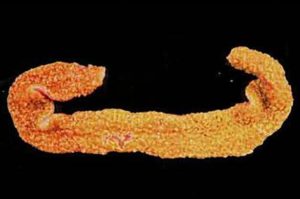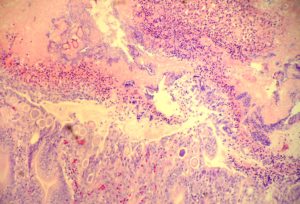Necrotic enteritis in broilers
By Gabriel Senties-Cue MVZ, EPAA, MS
With over 800,000 tests run annually, TVMDL encounters many challenging cases. Our case study series will highlight these interesting cases to increase awareness among veterinary and diagnostic communities.
Necrotic enteritis associated with coccidiosis was diagnosed in 25-day-old broilers. Six live broilers with a history of increased mortality with birds dying with their legs straight out were submitted for laboratory examination. At necropsy, the mucosa of the jejunum and ileum had a “cloth towel” appearance with loose, small mucosal flakes. Moderate numbers of coccidia were detected by the wet mount technique. The diagnosis of necrotic enteritis was confirmed by histopathology, which revealed necrosis of the upper part of the intestinal mucosa associated with large numbers of both rod-shaped bacteria and coccidia. Necrotic enteritis is caused by toxins secreted by Clostridium perfringens, which proliferates in the intestinal lumen when damage of the intestinal mucosa occurs. Coccidiosis is the main predisposing factor to necrotic enteritis.
To learn more about this case, contact Dr. Senties-Cue, Center Resident Director. For more information on TVMDL’s test catalog, visit tvmdl.tamu.edu.

